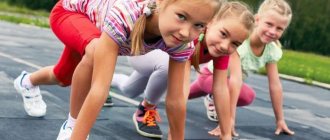Project on health conservation in the second junior group “Our health is in our hands”
Health-improving gymnastics (with ball)
Project passport.
The project is used when working in the second junior group of MBDOU d/s No. 80 “Solnechny” in Bryansk according to the approximate basic general education program “From birth to school” edited by N.E. Verencier, T.S. Komarova, M.A. Vasilyeva (2016).
Type of project: group, educational, creative, gaming.
Forms of conduct: classes, conversations, observations, didactic games, reading fiction.
Project duration: short-term (1 week).
Venue: group, music hall, group area, family.
Project participants: group teacher, children of the second junior group and their parents.
Relevance.
In the autumn, there is an increase in the incidence of children. It is necessary to create conditions in the group for maintaining and strengthening health. At this age, children are still little familiar with the concept of how to lead a healthy lifestyle. In everyday work with children, monitor compliance with the rules of personal hygiene in kindergarten and introduce children and their parents to a healthy lifestyle.
Objective of the project.
— Involving children and their parents in the educational process; develop physical qualities in children and instill a desire to lead a healthy lifestyle.
Project objectives.
Educational.
- Give an idea of a healthy lifestyle.
- Form rules for maintaining personal hygiene.
- Strengthen children's health through the educational process.
Developmental.
- Strengthen children's knowledge about the rules of personal hygiene.
- To develop in children the desire and ability to perform morning exercises, corrective exercises, etc.
Educational.
- Instill an interest in leading a healthy lifestyle.
- Cultivate a desire to engage in physical education, strengthen yourself, and take care of your health.
- Strengthen the relationship between the teacher and the family on issues of health and preservation of children.
Expected results.
- Reducing the incidence of children in the younger group.
- Health promotion through a system of health work in a group.
- Improving children's skills to observe cultural and hygienic procedures.
- The desire of children and parents to take care of their health.
Implementation stages:
Stage 1 - organizational.
Selection of material for this project, planning, involvement of parents for the implementation of this project.
Stage 2 – educational.
Summarizing thematic educational activities, observations, conversations, physical education and recreational work.
Stage 3 – practical.
Learning elements of breathing exercises, morning exercises, corrective exercises, nursery rhymes, finger games riddles, drawing.
Stage 4 is final.
- Conducting physical education activities on the topic: “Let’s grow up strong and healthy.”
- Conducting a parent meeting on the topic: “Being on the move means improving your health.”
Forms of project implementation.
- Observation, conversations, GCD, game situations, reading fiction, tasks, looking at plot pictures, illustrations, didactic games, outdoor games, morning exercises, after-sleep exercises, breathing exercises.
- Consultation for parents.
Project implementation methods.
Verbal:
Conversations, problem situations and the teacher’s story, riddles, nursery rhymes, reading fiction.
Practical.
Productive activity, drawing, physical education class, physical education leisure, music class, photographs of children in different routine moments.
Gaming.
Game situations, didactic games, outdoor games, role-playing games.
Abstract of GCD on cognitive development.
Topic: “Our bunny is sick.”
Goals: To give children the idea that a mother takes care of her family, her beloved child: she knows how to examine the throat, skin, put on a thermometer, measure temperature, put mustard plasters. Build respect for mom.
Techniques:
- Meeting with Doctor Aibolit.
- Riddles about medical items.
- Examination and description of riddle objects.
- Treatment of a bunny by children.
- Conversation about the care of mothers and grandmothers for children.
- Game situations.
- Summarizing.
Summary of GCD for speech development.
Topic: “Doll Katya got sick.”
Objectives: To develop children’s ability to write short narrative stories. Improving speaking skills.
Techniques:
- Surprise moment.
- A conversation with the doll Katya about how she got sick.
- Didactic game “Treating the doll Katya.”
- Compose a story together with the teacher.
- Telling a story with 2-3 children.
- Summarizing.
Summary of GCD for drawing.
Topic: “Multi-colored hoops.”
Goals: To develop the ability to draw round objects with a continuous brush movement.
Techniques:
- Examining the hoops, determining the shape.
- Finger drawing in the air.
- Teacher's demonstration.
- Children doing work.
Abstract of GCD in music.
Topic: “The bunny washes itself.”
Goals: To create a healthy lifestyle.
Techniques:
- Musical and rhythmic movements: “Feet off the ground.”
- Song: “The bunny washes itself.”
- Exercise: “Frogs by the pond.”
- Game: "Moidodyr".
- Gymnastics: “Raise your arms.”
- Warm-up: “Two little frogs.”
- Breathing exercises: “Hedgehogs”.
Abstract on physical education.
Topic: “Grow up strong and healthy.”
Goals: To create a joyful mood in children. Enjoy joint activities and educational games. To form the concept of leading a healthy lifestyle in children.
Working with parents:
- A corner for parents has been set up with the theme: “Health is fine - thanks to exercise.”
- Consultation: “Hardening is the key to health in our hands.”
- Memo for parents: “Formation of a healthy lifestyle in children.”
Project summary:
Children in the younger group have an increased desire to engage in physical education, morning exercises, after-sleep exercises, finger exercises, breathing exercises, and to take an active part in hardening procedures. Children have developed knowledge and skills about leading a healthy lifestyle. In order to increase the desire and interest of children and their parents to lead a healthy lifestyle, develop physical qualities, and continue to work in this direction in new projects.
Bibliography:
- Penzulaeva L. I. Health-improving gymnastics for children 3-7 years old. Ed. Mosaic-Sintez, Moscow 2010
- Morgunova O. N. Physical education and health work in preschool educational institutions. Practical guide. Voronezh, 2007
- Gubanova N. F. Development of gaming activities in the second junior group. Mozaika-Sintez, M., 2009
- Dzyuba P. P. Didactic piggy bank for a kindergarten teacher. Rostov N/A: Phoenix 2008
- Draco M.V. Educational finger games. Ed. “Medley”, Minsk 2009


